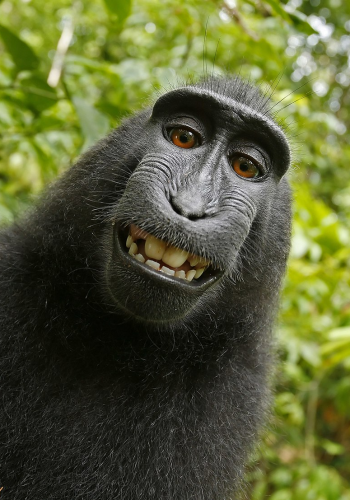Selfies - It’s So Easy, a Monkey Could Do It
Much like it is in various other creative endeavours, the issue of copyright and ownership has long been present in the world of photography. Generally speaking, copyright law says that when an individual has taken a photograph, the taker becomes the owner of the rights to that image.
There have been numerous instances where both those behind and in front of the camera have claimed ownership or in some cases co-ownership (as argued in the copyright case against Gigi Hadid) of the images taken. Some end up being settled with simple removals or with proper accreditation applied to the rightful owners of the images. Others, however, have ended up in the highest courts and have created interesting precedents for all parties concerned, good and bad.
However, what happens when there is no precedent set for the rights owners, considering that the individual taking the photograph isn’t even part of the same species? You’d think that in such circumstances, it would be an open-and-shut case. Sadly, for wildlife photographer David Slater, getting to the truth ended up being a little stranger than anyone could have imagined and the resulting legal proceedings took 7 years before a resolution was presented.
What transpired was the unusual situation where an animal, in this case, a Celebes crested macaque, was responsible for taking a number of photographs of themselves, effectively doing what became known all over the world as a “monkey selfie”. While most of the images taken by the monkey were blurred, there were a few, and one in particular, where the animal was perfectly framed and in focus and provided what most of the world thought was, a super cute image of a smiling monkey (see below).

Raising awareness through photography
But we’re getting ahead of ourselves a little, so let’s backtrack to 2011 when this whole saga began. Nature photographer David Slater had travelled to Sulawesi, Indonesia in an attempt to photograph the (still) critically endangered Celebes crested macaques in an effort to raise awareness of the plight of the animals through his photography. The process proved to be more difficult than he imagined, resulting in a rethink on the part of Slater.
“I wanted a close-up image but I couldn’t do it. They were too nervous, so I had to get them [the monkeys] to come to the camera without me being there and get them to play with the release, which they did”, Slater said.
He had set up his camera on a tripod, along with an attached wide-angle lens, and had ensured that the camera’s settings were optimized for capturing better facial close-ups, with predictive autofocus, motor drive and a flashgun. Slater further stated that he set the camera’s remote shutter trigger next to the camera and, while he held onto the tripod, the monkeys spent 30 minutes looking into the lens and playing with the camera gear, triggering the remote trigger multiple times and capturing numerous photographs.
The ‘monkey selfie’ goes viral
Upon completion of the project in 2011, the resulting photographs ended up being shared across a number of different news organisations and online publications with certain outlets attributing appropriate accreditation to David Slater, while others didn’t. The UK’s Daily Mail was the first publication to pick up on and share the story and soon afterwards the monkey selfie went viral. However, things took a turn when the above portrait ended up on Wikimedia Commons as an image that is part of the public domain. When he tried to get Wikimedia to pull the image down from its “Commons” section in 2014, the editors responsible for curating the open-source content refused, stating that as far as they’re concerned, the image had no rights holder as it was neither Mr Slater’s image nor the monkey’s. If anyone came across the image on the site at the time, they would be greeted with:
‘This file is in the public domain because as the work of a non-human animal, it has no human author in whom copyright is vested.‘
What followed was a process that took longer than anyone could have expected, especially, when looking at all the details and circumstances. To many, it seemed like an open-and-shut case. However the debate in the public domain had been mixed, with some advocating for the rights of the monkey as the copyright owner, and others siding with the human instigator of the whole process. One entity that was very much in favour of the animal was PETA, the nonprofit animal rights organization (more on them in a little bit).
In the meantime, thanks to its availability on Wikimedia Commons, the image had been used across the board by various outlets and private individuals, anyone could download a high-resolution version and do with it whatever they chose. From Slater’s (quite justifiable) perspective, thanks to these circumstances, his financial standing had been eroded and simply put, he wasn’t seeing a cent from the image. In an effort to secure some funds from the photograph (along with many others taken), Slater had put together a photography book titled “Wildlife Personalities” filled with images and text celebrating the different animals he had interacted with, along with, of course, the Crested black macaque, which also graces the book’s cover.
PETA takes legal action
It is at this point that the aforementioned PETA becomes intimately involved in the case, by taking legal action against Slater (and the self-publishing platform, Blurb) and filing a lawsuit on behalf of the Sulawesi crested macaque (named Naruto in the suit), arguing the animal owns the copyright (along with all the proceeds generated from the image(s)).
Under common law, there is a precedent called ”next friend”, a person (or entity) who represents another person that might be underage, or, perhaps due to a disability or similar, is unable to be represented in court. And seeing as this person wasn’t even a person and they also happened to be on the other side of the world in Indonesia, the motives behind the legal action come across as dubiously altruistic.
For those on the outside, this legal wrangling must have seemed farcical at times, but to the person whose livelihood was on the line, it was anything but. David Slater had to spend the next 3 years in court (remotely though, much like Naruto, he was unable to fly to the United States where the proceedings were taking place) arguing for his livelihood and engaged in a tug of war with an organisation bent on pushing its animal rights message to all, no matter how tenuous that connection might have been in this particular case. The prosecution wanted the proceeds generated by the photo to be administered by PETA for the benefit of the monkey, as well as other crested macaques living on the same reserve on Sulawesi.
Who is Naruto?
From the get-go, the motives behind the case were questionable. Crucially, there were inconsistencies in identifying the monkey, where, according to PETA and its legal team, the plaintiff was a 6-year-old male called Naruto. However, Slater stated that the monkey that took the famous selfie was, in fact, female.
When talking to Vice about the case back in 2015, Slater made the following statement via email:
“All you need to know is PETA have no proof they are talking about the same monkey. They hope you will buy into their stunt because an expert is willing to say her monkey is the one in my photos without proof.”
Even PETA’s president, Ingrid Newkirk had thought as much when she wrote about it back in 2014, arguing for the rights of the monkey. Beyond the confusion, there’s also the fact that male crested macaques are about twice the size of a female and crucially have enlarged canine teeth, whereas the monkey in the photo does not.
Even with experts being brought in to identify the sex of the animal, arguing both for and against it being a male, a satisfying conclusion remained elusive. Carol Berman, who had collaborated with those involved with the Macaca Nigra Project and was speaking on behalf of PETA, would ultimately come to the following “conclusion”:
“Based on the teeth, that monkey is “either a female or a young male.”
Dismissal, appeal and agreement
Come January 2016, Judge William Orrick would dismiss the case, arguing that an animal doesn’t have the legal right to be the copyright holder of the photograph, only to be appealed by PETA in March of the same year. With further legal ramblings, the case would finally reach an agreement between Slater, Blurb and PETA in September 2017, providing the following joint statement:
“PETA and David Slater agree that this case raises important, cutting-edge issues about expanding legal rights for non-human animals, a goal that they both support, and they will continue their respective work to achieve this goal.”
According to the agreement, Slater would donate 25% of any future revenues from the photograph towards charities that protect the wildlife and habitat of endangered species like Naruto. However, the case itself wouldn’t end up ruling in Slater’s favour until April 2018, due to further implications these unique circumstances brought to the US legal system (we won’t bore you with the details here, after all, we are a photography blog!).
The high cost of victory
So, while David Slater would emerge victorious at the end of this long and drawn-out affair, it wasn’t without consequences. During the trial, much of his personal income had dwindled, thanks to ongoing legal costs, not to mention the income lost from revenue created by the photograph. By Slater’s own estimation, an amount close to £10k. His inability to travel to the United States and be physically present in court was also due to financial loss at the time. But perhaps most tellingly, it was his passion for photography and taking photographs that had all but disappeared as a result of everything that transpired.
However, this whole episode did in fact yield exactly the result that Slater had hoped for, all the way back in 2011 when he embarked on the project. He realised as much when he commented on the situation in 2017:
“It has taken six years for my original intention to come true which was to highlight the plight of the monkeys and bring it to the world. No one had heard of these monkeys six years ago, they were down to the last thousands. … The locals used to roast them, but now they love them, they call it the ‘selfie monkey’.”
While no one could have predicted just how protracted and painful the whole ordeal would be for one individual, thanks to the unique circumstances that transpired, the plight of the crested black macaque is far better than what it was ever before. And, for the time being, whilst they continue to enjoy their newfound fame and popularity with both locals and tourists alike, we can only hope they’ll remain distracted from taking up any new hobbies.
